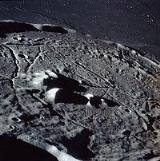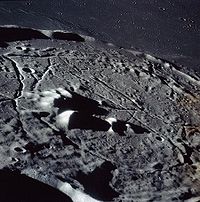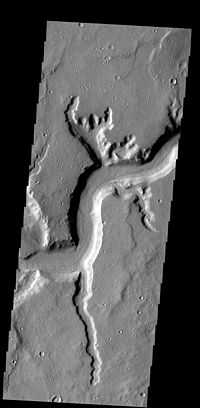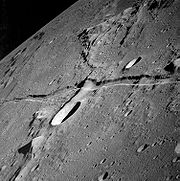
Rille
Encyclopedia
Rille is typically used to describe any of the long, narrow depressions in the lunar
surface that resemble channels
. Typically a rille can be up to several kilometers wide and hundreds of kilometers in length. However, the term has also been used loosely to describe similar structures on a number of planets in the Solar System, including Mars, Venus, and on a number of moons. All bear a structural resemblance to each other.



Rilles which show more than one structure are termed hybrid rilles. Rima Hyginus in Sinus Medii
is an example, initially formed through a fault and subsequently subject to volcanic activity.
s, collapsed lava tubes, near-surface dike intrusion, nuee ardente (pyroclastic cloud), subsidence of lava-covered basin and crater floors, and tectonic extension. On-site examination would be necessary to clarify exact methods.
that may connect to an underground lava tube
. The hole is 65 metres in diameter and may extend downward at least 80 metres. The lava tube may have a diameter of 370 metres. This tube could provide radiation shielding for an underground lunar colony. However, it is unclear whether the tube is open or accessible. Two other lunar sites have been found by remote sensing, including on the far side's Mare Ingenii
.
Moon
The Moon is Earth's only known natural satellite,There are a number of near-Earth asteroids including 3753 Cruithne that are co-orbital with Earth: their orbits bring them close to Earth for periods of time but then alter in the long term . These are quasi-satellites and not true moons. For more...
surface that resemble channels
Channel (geography)
In physical geography, a channel is the physical confine of a river, slough or ocean strait consisting of a bed and banks.A channel is also the natural or human-made deeper course through a reef, sand bar, bay, or any shallow body of water...
. Typically a rille can be up to several kilometers wide and hundreds of kilometers in length. However, the term has also been used loosely to describe similar structures on a number of planets in the Solar System, including Mars, Venus, and on a number of moons. All bear a structural resemblance to each other.



Structures
Three types of rille are found on the lunar surface:- Sinuous rilles meanderMeanderA meander in general is a bend in a sinuous watercourse. A meander is formed when the moving water in a stream erodes the outer banks and widens its valley. A stream of any volume may assume a meandering course, alternately eroding sediments from the outside of a bend and depositing them on the...
in a curved path like a mature river, and are commonly thought to be the remains of collapsed lava tubeLava tubeLava tubes are natural conduits through which lava travels beneath the surface of a lava flow, expelled by a volcano during an eruption. They can be actively draining lava from a source, or can be extinct, meaning the lava flow has ceased and the rock has cooled and left a long, cave-like...
s or extinct lavaLavaLava refers both to molten rock expelled by a volcano during an eruption and the resulting rock after solidification and cooling. This molten rock is formed in the interior of some planets, including Earth, and some of their satellites. When first erupted from a volcanic vent, lava is a liquid at...
flows. They usually begin at an extinct volcanoVolcano2. Bedrock3. Conduit 4. Base5. Sill6. Dike7. Layers of ash emitted by the volcano8. Flank| 9. Layers of lava emitted by the volcano10. Throat11. Parasitic cone12. Lava flow13. Vent14. Crater15...
, then meander and sometimes split as they are followed across the surface. Vallis SchröteriVallis SchröteriSchroter's Valley, frequently known by the Latinized name Vallis Schröteri, is a sinuous valley or rille on the surface of the near side of the Moon. It is located on a rise of continental ground, sometimes called the Aristarchus plateau, that is surrounded by the Oceanus Procellarum to the south...
in Oceanus ProcellarumOceanus ProcellarumOceanus Procellarum is a vast lunar mare on the western edge of the near side of the Earth's Moon. Its name derives from the old superstition that its appearance during the second quarter heralded bad weather...
is the largest sinuous rille.
- Arcuate rilles have a smooth curve and are found on the edges of the dark lunar mariaLunar mareThe lunar maria are large, dark, basaltic plains on Earth's Moon, formed by ancient volcanic eruptions. They were dubbed maria, Latin for "seas", by early astronomers who mistook them for actual seas. They are less reflective than the "highlands" as a result of their iron-rich compositions, and...
. They are believed to form when the lavaLavaLava refers both to molten rock expelled by a volcano during an eruption and the resulting rock after solidification and cooling. This molten rock is formed in the interior of some planets, including Earth, and some of their satellites. When first erupted from a volcanic vent, lava is a liquid at...
flows that created a mareLunar mareThe lunar maria are large, dark, basaltic plains on Earth's Moon, formed by ancient volcanic eruptions. They were dubbed maria, Latin for "seas", by early astronomers who mistook them for actual seas. They are less reflective than the "highlands" as a result of their iron-rich compositions, and...
cool, contract, and sink. These are found all over the moon, examples can be seen near the south-western border of Mare TranquillitatisMare TranquillitatisMare Tranquillitatis is a lunar mare that sits within the Tranquillitatis basin on the Moon. The mare material within the basin consists of basalt formed in the intermediate to young age group of the Upper Imbrian epoch. The surrounding mountains are thought to be of the Lower Imbrian epoch, but...
and on the south-eastern border of Mare HumorumMare HumorumMare Humorum is a lunar mare. The impact basin it is located in is 825 kilometers across. It was not sampled by the Apollo program, so a precise age has not been determined. However, geological mapping indicates that it is intermediate in age between the Imbrium and Nectaris Basins, suggesting an...
.
- Straight rilles follow long, linear paths and are believed to be grabenGrabenIn geology, a graben is a depressed block of land bordered by parallel faults. Graben is German for ditch. Graben is used for both the singular and plural....
s, sections of the crust that have sunk between two parallel faultsGeologic faultIn geology, a fault is a planar fracture or discontinuity in a volume of rock, across which there has been significant displacement along the fractures as a result of earth movement. Large faults within the Earth's crust result from the action of tectonic forces...
. These can be readily identified when they pass through craterImpact craterIn the broadest sense, the term impact crater can be applied to any depression, natural or manmade, resulting from the high velocity impact of a projectile with a larger body...
s or mountain ranges. Vallis AlpesVallis AlpesVallis Alpes is a lunar valley feature that bisects the Montes Alpes range. It extends 166 km from the Mare Imbrium basin, trending east-northeast to the edge of the Mare Frigoris. The valley is narrow at both ends and widens to a maximum width of about 10 km along the middle stretch...
is by far the largest graben rille, indeed it is regarded as too large to be called a rille and is itself bisected by a straight rille; Rupes RectaRupes RectaRupes Recta is a linear fault, or rille, on the Moon, in the southeastern part of the Mare Nubium at . The name is Latin for "Straight Fault", although it is more commonly called the Straight Wall...
in Mare NubiumMare NubiumMare Nubium is a lunar mare in the Nubium basin on the Moon's near side. The mare is located just to the southeast of Oceanus Procellarum. The actual basin is believed to be of Pre-Nectarian system, with the surrounding basin material being of the Lower Imbrian epoch. The mare material is of the...
is a clearer example.
Rilles which show more than one structure are termed hybrid rilles. Rima Hyginus in Sinus Medii
Sinus Medii
Sinus Medii is a small lunar mare that is located at the intersection of the Moon's equator and prime meridian. As seen from the Earth, this feature is located in the central part of the Moon's near side, and it is the point closest to the Earth...
is an example, initially formed through a fault and subsequently subject to volcanic activity.
Formation
Precise formation mechanisms of rilles have yet to be determined. It is likely that different types formed by different processes. Common features shared by lunar rilles and similar structures on other bodies suggest that common causative mechanisms operate widely in the solar system. Leading theories include lava channelLava channel
A lava channel is a stream of fluid lava contained within marginal zones of static lava or levees. The initial channel may not contain levees per se, until the parental flow solidifies over what develops into the channel and creates simple levees. This initial levee allows for the building of a...
s, collapsed lava tubes, near-surface dike intrusion, nuee ardente (pyroclastic cloud), subsidence of lava-covered basin and crater floors, and tectonic extension. On-site examination would be necessary to clarify exact methods.
Potential
In 2009, a hole was found in the lunar surface near the Marius HillsMarius Hills
The Marius Hills are a set of volcanic domes located in Oceanus Procellarum on Earth's Moon. The domes are thought to have formed from lavas fairly more viscous than those that formed the Lunar mare. These domes average approximately 200–500 m in height. The Marius Hills take their name from the...
that may connect to an underground lava tube
Lava tube
Lava tubes are natural conduits through which lava travels beneath the surface of a lava flow, expelled by a volcano during an eruption. They can be actively draining lava from a source, or can be extinct, meaning the lava flow has ceased and the rock has cooled and left a long, cave-like...
. The hole is 65 metres in diameter and may extend downward at least 80 metres. The lava tube may have a diameter of 370 metres. This tube could provide radiation shielding for an underground lunar colony. However, it is unclear whether the tube is open or accessible. Two other lunar sites have been found by remote sensing, including on the far side's Mare Ingenii
Mare Ingenii
Mare Ingenii is one of the few lunar mare features on the far side of the Moon. The mare sits in the Ingenii basin. This basin material is of the Pre-Nectarian epoch. The mare material located in Ingenii and the surrounding craters is of the Upper Imbrian epoch...
.
See also
- Arachnoid (astrogeology)Arachnoid (astrogeology)In astrogeology, an arachnoid is a large structure of unknown origin, and they have been found only on the surface of the planet Venus. Arachnoids get their name from their resemblance to spider webs. They appear as concentric ovals surrounded by a complex network of fractures, and can span 200...
- Chaos terrainChaos terrainChaos terrain is an astrogeological term used to denote planetary surface areas where features such as ridges, cracks, and plains appear jumbled and enmeshed with one another. Chaos terrain is a notable feature of the planet Mars and Jupiter's moon Europa...
- Dark dune spotDark dune spotMartian geysers are putative sites of small-scale jet-like eruptions that are believed to occur in the south polar region of Mars during the spring thaw. "Dark dune spots" and "spiders" are the two most visible types of features ascribed to these eruptions. They are unlike any terrestrial...
- List of features on the Moon
- Lunar lava tubeLunar lava tubeLunar lava tubes are sub-surface tunnels on the Moon that are believed to have formed during basaltic lava flows. When the surface of a lava tube cools, it forms a hardened lid that contains the ongoing lava flow beneath the surface in a conduit-shaped passage. Once the flow of lava diminishes, the...
- Martian spiders
- Planetary geologyPlanetary geologyPlanetary geology, alternatively known as astrogeology or exogeology, is a planetary science discipline concerned with the geology of the celestial bodies such as the planets and their moons, asteroids, comets, and meteorites...
- Splitting of the moonSplitting of the moonThe splitting of the moon was a miracle performed by Muhammad in Islamic tradition. The incident is mentioned in Muslim traditions as the context of revelation for the Qur'anic verse where some Muslim commentators accept the historicity of the miracle and some reject it..Early traditions...

